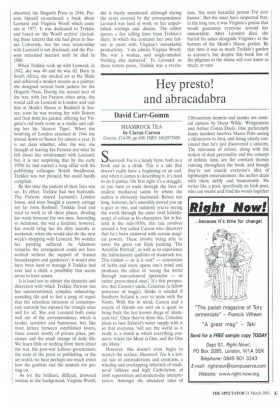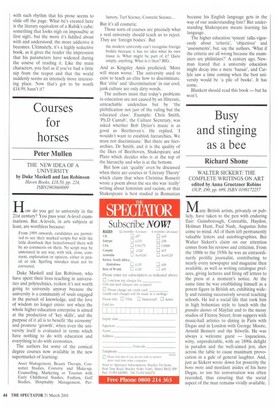Hey presto!
and abracadabra
David Carr-Gomm
SHAMROCK TEA by Ciaran Carson Granta, £14.99, pp.308, ISBN 1862073988
Shamrock Tea is a heady brew, both as a book and as a drink. This is a tale that doesn't really have a beginning or an end, and when it comes to describing it, it's hard to do it justice. On first sight it's a struggle, as you have to wade through the lives of endless mediaeval saints by whom the author is obviously fascinated. Before too long, however, he's smoothly moved you up a gear or two, and suddenly you're seeing the world through the same vivid kaleidoscope of colour as his characters. Set in Ireland in the mid-1950s, this tale revolves around a boy called Carson who discovers that he's been endowed with certain magical powers. These involve being able to enter the great van Eyck painting 'The Arnolfini Portrait', as well as to experience the hallucinatory qualities of shamrock tea. This fabled — or is it real? — concoction of herbs and roots opens one's mind and produces the effect of 'seeing the world through rose-coloured spectacles — or rather green-tinted ones'. It's this perspective that Carson's uncle, Celestine (a fellow possessor of magic), thinks is needed if Southern Ireland is ever to unite with the North. With this in mind, Carson and a couple of friends are sent on a quest to bring back the last known dregs of 'shamrock tea'. Once they've done this, Celestine plans to lace Ireland's water supply with it so that everyone 'will see the world as it really is, a world in which everything connects; where the Many is One, and the One are Many.'
However, this doesn't even begin to scratch the surface. Shamrock Tea is a lyrical tale of contradictions and contrasts, a winding and overlapping labyrinth of mediaeval folklore and high Catholicism, of Irish superstition and modern-day interpretation. Amongst the abundant tales of 13th-century hermits and monks are comical cameos by Oscar Wilde, Wittgenstein and Arthur Conan Doyle. One particularly funny incident involves Marco Polo seeing a rhinoceros in Java, and being utterly convinced that he's just discovered a unicorn. The relevance of colour, along with the notion of dual personality and the concept of infinite time, are the constant themes running throughout the book, and though they're not exactly everyone's idea of lightweight entertainment, the author deals with them deftly and humorously. He writes like a poet, specifically an Irish poet, who can weave and bind his words together with such rhythm that his prose seems to slide off the page. What he's created here is the literary equivalent of a Rubik's cube: something that looks nigh on impossible at first sight, but the more it's fiddled about with and understood, the more addictive it becomes. Ultimately, it's a highly seductive book, as it gives the reader the impression that his parameters have widened during the course of reading it. Like the main characters, you feel as if you've had a little nip from the teapot and that the world suddenly seems an intensely more interesting place. Now that's got to be worth 114.99, hasn't it?



























































































 Previous page
Previous page